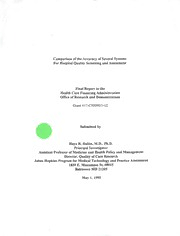
Comparison of the accuracy of several systems for hospital quality screening and assessment : final report to the Health Care Financing Administration, Office of Research and Demonstrations PDF
Preview Comparison of the accuracy of several systems for hospital quality screening and assessment : final report to the Health Care Financing Administration, Office of Research and Demonstrations
ComparisonoftheAccuracyofSeveralSystems ForHospitalQualityScreeningandAssessment FinalReporttothe HealthCareFinancingAdministration OfficeofResearchandDemonstrations Grant#17-C90099/3-02 Submittedby HayaR.Rubin,M.D.,Ph.D. PrincipalInvestigator AssistantProfessorofMedicineandHealthPolicyandManagement Director,QualityofCareResearch JohnsHopkinsProgramforMedicalTechnologyandPracticeAssessment 1830E.MonumentSt.#8015 BaltimoreMD21205 May1,1995 ComparisonoftheAccuracyofSeveralSystems ForHospitalQualityScreeningandAssessment Grant#17-C90099/3-02 FinalReport TableofContents EXECUTIVESUMMARY 2-4 BACKGROUND 4 PURPOSEANDAIMS 5 METHODS 5-9 RESULTS 9-13 CONCLUSIONSANDRECOMMENDATIONS 13-15 REFERENCES . 16 TABLES(1-36) APPENDICES(A1-A3) 1-25 AbbreviationsusedinAppendixTables 26 EXECUTIVESUMMARY Background: TheHealthCareFinancingAdministrationcontractswithpeerreview organizations(PROs)toobtainphysicianreviewofmedicalrecords. Whiletheresultsof individualcasereviewbyoneortwophysicianshavebeenrecognizedtobeunreliable,and HCFAnolongercontractswithPROstoactonresultsofindividualreviews,resultsof reviewofgroupsofpatientstreatedbyagivenphysicianorproviderareusedbyHCFAto helpphysiciansandprovidersidentifyqualityimprovementopportunities. Tomakethereviewprocessmoreefficient,ithasseemeddesirabletousea screeningstrategytodecidewhichrecordsshouldbereferredtoaphysician,thusutilizing moreexpensivephysiciantimemostefficiently. Suchscreeningsystemshavereceived littleevaluationandrarelyhavealternativesbeendirectlycompared. HCFAisdeveloping theUniformClinicalDataSet;onefunctionofthisdatasetwastoprovideautomated algorithmstoscreencasesforwhethertheyshouldbereferredforreview. Aims:Thepurposeofthisstudywastomeasurethesensitivity,specificityandpredictive valueofthreedifferentmedical-recordbasedscreeningsystemsforqualityofcare problemsexperiencedbypatientswithcoronaryarterydiseasehospitalizedformyocardial infarction(MI),percutaneoustransluminalcoronaryangioplasty(PTCA)orcoronary arterybypassgraft(CABG)surgery: Thethreescreeningsystemswere: 1)anearlyprototypeoftheUniformClinicalDataSet (UCDS)thatwasbeing pilottestedbyseveralpeerrevieworganizationsatthetimethestudywasundertaken; 2)JohnsHopkinshospital-wide(JHH)screens,includingHCFAgenericscreens thatwereusedbymanypeerreviewoganizations 3)theHarvardMedicalPracticeStudy(HMPS)screeningcriteria, Thestudyoriginallyproposedtomeasurethescreeningsystemsagainsttwodifferent referencestandards,blindedtothescreeningresults: 1)agreementbyatleasttwo reviewingcardiologiststhattherewasaqualityofcareproblem,2)thedeterminationthat anadverseeventwasduetonegligence,asdefinedintheHarvardMedicalPracticeStudy. Methods: Astratifiedsampleof460medicalrecordswasdrawninthreestrata: myocardial infarction,coronaryangioplasty,andcoronaryarterybypasssurgery,fromadmissionsin theperiod7/1/89-6/30/91atJohnsHopkinsHospital. Withineachcohort,thesamplealso wasstratifiedbywhetherornotrecordshadpassedJohnsHopkinsHospital'shospital- widequalityscreens. Recordswerescreenedusingallthreescreeningsystemsbytrained qualityassurancenurses. Allrecordswerealsoreviewedbytwotothreecardiologists usingstructuredimplicitreviewinstrumentstodeterminethereferencestandards. All recordswerealsocodedforAPACHE-III severityofillnessscoresandtheCharlson comorbidityindex.ROC-likecurveswereobtainedusingdifferentsubsetsofscreensand theareaunderthecurvecomparedforthesedifferentsubsets. Ninerecordswere unavailableforreviewandtwenty-eightwerereviewedbyonlyonephysicianandwere excludedfromthestudyresultsthatusetwophysicianreviews. Results: Agreementamong physicians aboutwhethertherewasaqualityproblemornotwas76% (kappa0.37). Bothphysiciansagreedthattherewasaqualityproblemin17.8%ofcases, poolingallthreecohorts,andadjustingforthestratificationprocedures.Inallthree screeningsystemsasmallnumberofscreensdetectedmostofthequalityproblems. Overallagreementinthenursescreeningresultaboutwhethertoreferarecordfor physicianreviewwas98%forUCDS,77%forJHH,and85%forHMPS. Thesystems performedasfollowsindetectingqualityproblemsagreeduponbyatleasttwoofthe cardiologyreviewers: Positive MDhrs RNhrs Predictive perdetected perdetected Sensitivity Specificity Value problem problem UCDS 85%(+/-16) 48%(+/-12) 25%(+/-ll) 2.1 6.7 JHH 74%(+/-12) 57%(+/-ll) 27(+/-12) 1.9 1.9 HMPS 69%(+/-16.3) 56%(+/-12) 26(+/-ll) 2.0 2.0 SensitivitywassimilarforallcohortsforUCDS,andbetterthanJHHandHMPSforall. SensitivityforMIpatientscannotbeevaluatedproperlyduetotheabsenceofquality problemsmakingitimpossibletoproducepooledestimatesinthatcohort. Specificityof JHHandHMPSscreensexceededthatofUCDSforPTCAandMIpatients. Positive predictivevaluesforUCDSweresimilarforallcohorts,andsimilartothatofJHHand HMPSscreens,exceptfortheMIcohort,whichagainduetotheabsenceofquality problemsinonestratummadepooledestimatesdifficulttointerpret. Becauseofthis,the numberofphysicianandnursehoursperqualityproblemdetectedwasgreaterwithJHH andHMPSscreensthanforUCDSforMIpatients(physicianhours:JHH6.3,HMPS7.1, UCDS1.9,nursehours: JHH97,HMPS9.6,UCDS5.6). Forallothercohorts,nurse hoursperqualityproblemdetectedwere6.7hoursforUCDSand1-2hoursfortheother systems,whilephysiciantimeperqualityproblemwasapproximately2hoursforall systems. Conclusion: Forthecardiacpatientsatthishospital,theversionofUCDStestedwasmoresensitive andlessspecificfordetectingqualityproblemsthantheothertwoscreeningmethods,but wasmuchlessefficientperqualityproblemdetected. Therearedifferencesinsensitivity andspecificitydependingonwhetherpatientswereadmittedforMI,angioplasty,or bypasssurgery,withUCDSperformingsignificantlybetterinMIpatientsthantheother twosystems. Positivepredictivevaluesweresimilarforallthreemethodstestedandwere onlyabout25%inthispopulationwithaprevalenceof18%qualityproblems. Allsystems couldbestreamlinedforthesepopulationsofpatientstoincludeonlythehighestyield screenswithlittlelossofsensitivity. BACKGROUND Regulatoryeffortstomonitorqualityofcareforpayers,liketheHealthCareFinancing Administrations's(HCFA's)contractswithpeerrevieworganizations(PROs)aremoving towardmethodsofscreeningforqualityproblemsthatdependonaggregateanalysesof processesoroutcomesofcareforcohortsofpatients. Forsomeconditionswithadequate numbersofpatientsperproviderorperhospital,suchreviewcanbebaseduponrisk- adjustedoutcomesassessment. Forotherhighvolumepatientcohorts,theeffortand expensearejustifiedtocodifyguidelinesforcareandupdatethemregularly,andforsuch patientsqualityofcareislikelytobemonitoredusingreviewagainstexplicitcriteriabased ontheseguidelines. However,formostepisodesofcare,implicitreviewbyphysiciansof themedicalrecordorofobservedmedicalevents,remains,andprobablywillremain,an important,practicalwaytoidentifytherateandtypeofqualityproblemsthathave occurred. Althoughpeerreviewbyoneortwophysiciansisnotreliableenoughtodraw conclusionsaboutanindividualcase,itisasoundmethodforidentifyingpatternsand ratesofqualityproblemsforgroupsofpatients TheHCFAHealthStandardsandQualityBureaucontractswithPROstoreview medicalrecordsofhospitalizationstoidentifypatternsofqualityproblemsexperiencedby patientstreatedbyagivenphysicianorhospital. Hospitals'internaleffortstoassessand improvetheclinicalqualityofcarealsodependheavilyonpeerreviewbyphysicians. Becausephysicianreviewistime-intensive,screeningsystemstoidentifyrecordswith possiblequalityofcareproblems havebeenevolvedinanefforttosavephysicianreview timebydirectingittoahigheryieldgroupofrecords. HCFAfirstattemptedtogive guidanceinthescreeningprocessbydisseminatingtoPROsasetofgenericscreens. Thesemainlyconsistedofasetofadverseoutcomes. Asimilarsetofadverseoutcome screenswasalsodevelopedbyinvestigatorsconductingtheHarvardMedicalPractice Study,whoalsorequiredawaytoscreenrecordstodeterminewhichrequiredphysician review. Morerecently,HCFAdevelopedarecordabstractionsystemknownasthe UniformClinicalDataSet(UCDS). AlthoughtheUCDShasmanyotherpurposes, includingcollectingdataforrisk-adjustedoutcomesanalysesaswellasexplicitreviewfor patternsofcare,earlyprototypesoftheUCDSsoftwareincludedasetofembedded algorithmsdesignedtoflagmedicalrecordsthatshouldbereviewedbyaphysician. Theperformanceofscreeningsystems,intermsofsensitivity,specificity, predictivevalueandcostforidentifyingqualityproblems,hasrarelybeenevaluated. StudieshavedemonstratedtheHCFAgenericscreensandthemethodsusedbyonePRO havelowpredictivevalueandrelativelylowsensitivity(SanazaroandMills, 1991,Rubin 1992). ItwasunknownifthesetofalgorithmsdevelopedforUCDShadhighersensitivity andpredictivevalueandhowmuchbetterperformancewasachievedgivenwhatappeared tobeaveryextensivedataextractionfromthemedicalrecord. Inaddition,thecostper qualityproblemidentifiedhadnotbeendeterminedforanyofthescreeningmethods above. PURPOSEANDAIMS Thepurposeofthisstudywastoassessthesensitivity,specificity,predictivevalueand relativecostsofthreedifferentsystemsdesignedtoscreenmedicalrecordsforproblems withthequalityofhospitalcare. Thesystemswere1)asetofscreensusedbyJohns HopkinsHospitalthatincludedHCFAgenericscreensusedbythePROs,2)theHarvard MedicalPracticeStudy(HMPS)screens,and3)screeningalgorithmsembeddedinversion 3.01oftheUniformClinicalDataSet(hereafterreferredtoasUCDS). Thereference standardsusedtoestablishaqualityproblemwereajudgmentofsubstandard("below standard")carerenderedattheendofastructuredimplicitreviewmethoddevelopedat RAND(Rubinetal. 1990,1992),astandardizedsummaryqualityscoreobtainedby summingspecificaspectsofcareratedinthestructuredform,andajudgmentofwhether ornottherewasany"qualityproblem",determinedaftertherestofthereviewwas complete. Wealsousedamodificationofthephysicianformusedtodetermine negligenceusedbytheHarvardMedicalPracticeStudy(Brennanetal. 1989),butthis appliedonlytorecordswithadverseeventsandthuscouldnotbeusedasageneral referencestandard. Priortoundertakingthestudy,wemetwithHealthStandardsandQualityBureau staffatHCFAtodetermineinwhichpopulationitmightbemosthelpfultotestdifferent screeningsystems. StaffatthatpointintimeweretryingtorefineUCDSforvarious purposesinpatientswithcardiacdisease,andforesawitsevolutionintocondition-specific dataabstractionmodules. Theybelievedtheresultswouldvaryfromconditionto conditionandsuggestedbeginningwithcardiovasculardiseaseasHCFAwasbeginning withthoseconditionsinitseffortstoevolveotherformsofpatternandoutcomeanalysis aswell Therefore,thisstudywaslimitedtopatientswithcoronaryarterydisease, specifically,thoseenteringthehospitalbecauseofamyocardialinfarctionortoundergo coronaryangioplastyorbypasssurgery. Subsidiaryaimsofthestudyweretomeasureperformanceofthescreening systemsatdifferentlevelsofcomorbidityandseverityofillnessatadmission,aswellasto measuretheinterraterreliabilityofscreeningmethodsandphysicianreviewasappliedina hospitaluser'squalityassuranceprogram. METHODS Overview Asampleofmedicalrecords,stratifiedbywhetherornottheyhadpassedthehospital's ownscreeningreview(whichincludedtheHCFAgenericscreens)andalsostratifiedby whethertheywereadmittedforMI,PTCAorCABG,werescreenedbytrainednurses usingallthreesystems. Eachmedicalrecordalsounderwenttwoindependentreviewsby physicians. Interrateragreementwasassessedinasubsampleofcasesabstractedbytwo nurses,andforthetotalsamplebetweenthetwoindependentphysicianreviews. APACHEIIIandCharlsonscoreswerecalculatedforeachrecordaswell. SelectionofRecords RecordswerefrompatientsadmittedtoJohnsHopkinsHospital,an1100-bedurban teachinghospital. ThehospitalisareferralcenterforPTCAandCABGfromBaltimore, othercountiesinMaryland,andtheWashington,D.C.area;approximately1200PTCA . and800CABGoperationsareperformedannually. Routinely,qualityassurancenurses review100%ofrecordsusingasetofgenericindicatorsthatincludedHCFA'sgeneric CscAreBenGscaasseasfuwlelrseetduenftiinlemdiads-1I9C9D1-.9R-eCcMorcdosdewser36e.s1a0m-3p6l.ed19f;rPoTmC7A/1/c8a9setsharsouIgChD6-/930-/C9M1 codes36.01,36.02,36.05;andMIcasesasICD-9-CMdiagnosescodes410.XI. Thesamplewithineachcohortwasalsostratifiedbywhetherornottherecordhad failedthehospital'sownqualityassurancescreen,inordertoenrichthesamplewith qualityproblems. Thesizeofthesamplewasdeterminedbyhowlargeasamplewouldbe neededtoestimateatruesensitivityof50%towithin20%(othertruevaluesofsensitivity wouldrequireasmallersamplesize). Thesamplesizesneededwere: Needed Truepopulation Sample Sam CABG/Fail 281 72 177 CABG/Pass 1281 89 36 PTCA/Fail 136 57 114 PTCA/Pass 1169 89 32 Ml/Fail 41 29 34 Ml/Pass 243 69 56 Total 3151 405 460 Fiftyrecordswerere-abstractedtogiveus80%powertodetectatanalphaerrorof.05 thedifferencebetweenareliabilityfortwogroupsof40%and60%,oradifference betweenreliabilityfortwogroupsof60%and75%. RecordScreening Oneofthephysicianinvestigators(L.Camacho)underwenttrainingatWisconsinPROin UCDSversion3.01recordabstraction. HetrainedqualityassurancenursesatJohns HopkinstoabstractrecordsusingUCDSinthemedicalrecordsdepartmentofthe hospital,usinglaptopcomputers. DataelementscollectedbyUCDSinclude sociodemographics,admittinganddischargeinformation,medicalhistoryandphysical examination,laboratoryanddiagnostictests,endoscopy,operativeepisodes,treatment interventions,andhospitalcourse(adverseevents,admissiontospecialunits,etc.) Using automatedalgorithms,UCDSthengeneratesasummaryofwhetherthecasehasfailedany ofitsflags. TheUCDSalgorithmsareorganizedintogenericscreens,electivesurgery, disease-specificscreens,organ-specificscreens,anddischargestatus. Ineachdecision area,algorithmslookforaprimaryconditionwhichdefinesthecasesandthecontextin whichthescreenisapplicable. Thenitlooksforasecondaryconditionthattriggersa specificflag. Forexample,ifabloodtransfusionwasgiven(primarycondition)andthe patienthadanunexpectedeventofshockduetodrugortransfusionreactionwithinone dayafterthebloodtransfusion(secondarycondition),thefollowingflagisset: "Shock duetotransfusionreactionwithinonedayofbloodadministration". Acompletelistingof UCDSflagsisavailableinaccompanyingdocumentation(Camacho1994). ThesamenursesappliedJohnsHopkinsHospitalandHarvardMedicalPractice Studyscreens,whichhadalsobeenautomatedonthesamecomputers. JohnsHopkins HospitalscreensincludedHCFA'ssetofgenericscreens. Theyareeventsorsituations thoughttosignalapotentialforpoorqualitycare. Forexample,casesofunscheduled returntosurgeryonthesamehospitaladmissionforthesameconditionastheprevious surgeryortocorrectoperativeproblems,wouldfailscreening. ThefullsetofJHH screensaredescribedelsewhere(Camacho1994,AppendixB) HarvardMedicalPractice Studyscreensaresixteeneventsassociatedwithpotentialpoorqualitycare,overlapping somewhatwithJHHscreens(Camacho1994,AppendixB). Qualitycontrolfornurseabstraction: Allnurseabstractionswereoverreadby oneoftheinvestigatorstoconfirmaccuracyofidentificationvariables. Dr.Camacho abstracteddataforcomorbidityandseverityofillnessscores,andintheprocessbecame acquaintedwitheachrecordwellenoughtodetectifinappropriateflagshadbeen triggeredinUCDSduetoinaccuratedataabstraction. EachUCDSprintoutwasoverread andthemedicalrecordcheckedtoconfirmaberrantlabdataordiagnostictests,or suspicous-lookingdata. PhysicianReview Eachrecordwasreviewedbytwoorthreephysiciansusing1)amodificationofa structuredimplicitreviewformforhospitalcarefordiversemedicalandsurgical conditions(Rubinetal.1990). Modificationsconsistedofaddingitemsaskingforbrief descriptionsofanyqualityproblemsandjustificationsforsomeanswers,addingtestsand treatmentsrelevanttocardiaccare,andexcludingsomeitemsthathadnotperformedwell inothersettings;and2)acondensedformoftheadverseeventanalysisformfromthe HarvardMedicalPracticeStudy(Brennanetal.1989),eliminatingitemsaskingaboutthe organsysteminvolvedintheadverseevent,whereittookplace,theresponsiblespecialty, andothersthatwerenotrelevanttothisstudy. Itemswereretainedthataskedabout whethertherewasinjury(morbiditynotcausedbythediseaseprocess),adverseevents (injuriescausedbymedicalmanagement),negligence(failuretomeettheaverage practitioner'sstandardofcareatthetimecarewasgiven),andscoresfortheconfidencein medicalcausationoftheadverseeventandconfidencethatnegligenceoccurred. We definednegligenceoradverseeventasrequiringascoreof4orhigheronthe6-point scale. Attheend,physicianswereaskedona"physicianopinionform"toreviewthe screeningresults(previouslysealed)tocommentonwhetheranyqualityproblemsfound wererelatedtothescreensthecasehadfailed,andinvitedacritiqueofthescreensasthey workedinthisparticularcase. Determiningreferencestandardfromphysicianreview Toincreasethereliabilityofreferencestandards,wedefined"substandard"careorquality problemonlywhentworeviewersagreeduponthedetermination. Forthesummary score,weusedthemeanofthetworeviews. Thesummaryscorewascalculatedusingonlyitemsonthestructuredimplicit reviewformthatshowedsomepredictiveabilityforselectedoutcomes(injury,adverse events,anddisability)inamultipleregressionmodel. Thefinalmodelhad14variablesto whichweightswereassignedaccordingtothestrengthoftheirrelationshiptodisabilityfor thatpatientcohort..Tocombineitemswithdifferentscales,itemswerescoredasaratio ofassignedtoapplicablepoints(RAAP). Summaryscoreswerealsoadjustedfor reviewers'ownmeanbysubstractingtheRAAPfromthatreviewer'smeanforallcaseshe hadreviewed,anddividingbythestandarddeviationforthewholesample. Acutoff standardizedscorewasthendeterminedthatmaximizedagreementwithdeterminationsof substandardcare,qualityofcareproblems,andnegligence. Inthisreport,weemphasizefindingsusingthereferencestandardofa"quality problem"fromthephysician'sopinionform,asthisdefinitionidentifiesopportunitiesfor improvementevenwhenthecareonaveragewasconsidered"standard"or"above standard"ontheimplicitreviewform. Analysesusingsubstandardcareandthesummary scoreasthereferencestandard,aswellasanalysesusingaqualityproblemjudgedby eitherreviewerratherthanboth,arereportedindetailelsewhere(Camacho1994, AppendixD). Assessmentofreliability Adetaileddescriptionofthemethodsusedtoassessreliabilityisavailable (Camacho1994). Inbrief,wecalculatedcrudeageement,kappa,andtwoalternativesto kappathathavebeenrecentlydescribed: theachievementratio,andkappa-free. These twostatisticsattempttoadjustthekappacalculationforthemaximumkappaachievable usingaparticulardistribution,askappaismisleadingwheneventsaredistributedina highlyskewedfashion,suchasqualityproblems. Kappa-freeassumesthattheapriori probabilityofaqualityproblemis50%inareviewersmind,ratherthanthedistribution foundpost-hoc. Inallthereportedanalyses,weassessthereliabilityofonereviewer'sjudgment. However,asareferencestandardinthestudy,weusedjudgmentsagreeduponbytwo reviewerswhichgreatlyincreasesthereliabilityofthefindings. Wealsocalculatedthe estimatedkappaofsuchtwo-reviewerconsensusjudgmentsbutdidnotmakethese calculationsusingkappa-freeandtheachievementratio. Peformanceofscreeningsystems Performanceofscreeningsystemsagainstthereferencestandardwasassessed usingsensitivityandspecificity,predictivevalue,andthenumberofnurse-hoursand physician-hoursperqualityproblemdetected. Forthelatter,weassumedhalfanhourper recordforphysicianreview. Forscreeningsystems,weusedHCFA'sestimateof65 minutesforUCDS3.01,and15minutesforJHHorHMPSbasedonourownexperience andthequalityassurancenurses'experience. Performanceofthescreeningsystemwas comparedtothesensitivity,specificity,predictivevalueandnurseandphysicianhoursper qualityproblemifthesamenumberofrecordswereselectedatrandomratherthan screenedinordertobereferredtophysicians. Allresults,bothofanalysesofinterrateragreementandofscreeningsystem performance,pooltheresultsofthetwostratawithineachconditionusingareweighting thatreflectstheoriginalproportionsofeachstratumforthatconditionasdetailedinthe sampleselectionabove. Whenresultsarepooledacrossconditions,theyarealsore- weightedtoreflecttheproportionsofadmissionswiththatconditioninthehospitalduring thetimeperiodexaminedinthestudy. RESULTS Sample About65%ofrecordswereavailableforreview;thusadditionalrecordswererequestedat randomuntiltheappropriatesamplesizewasreached. Atotalof460recordswere examined. There were511nurseabstractionsand951physicianreviews. Ninecases wereexcludedbecausetheprincipalprocedurewaswronglycoded,theclinicalcondition ofinterestwasnotpresent,orthereweretoomanymissingpartstoallowareview. 28 caseswereexcludedbecauseoneofthephysicianreviewsdidnotoccur. Fourteen percentofcaseswerereviewedbyathirdreviewer. CABGpatientswerepredominantlywhitemalesintheirsixtiesorseventies, retired,coveredbyprivatehealthinsuranceand/orMedicare,whohadhadaprevious hospitaladmissionforarelatedconditionintheprioryear. Coronaryatherosclerosiswas themostcommonprincipaldiagnosis,theyweredischargedtohomeintwoweeks,on average. PTCApatientsweretypicallywhite,slightlymorelikelytobemale,between55 and70,employedorretiredandcapableofself-care. Theywerecoveredbyprivate insurance,Medicare,orboth,andoftenhadnotbeenhospitalizedpreviouslyforarelated condition. Theirprincipaldiagnosiswasmostlikelytobecoronaryatherosclerosis,or, lessoften,anMI,andtheywerelessseverelyillwithlesscomorbiddiseasethanCABG andMIpatients. Asubstantialproportionhadadverseoccurrences,butfewhadintra- operativeadverseevents(PTCAisdefinedasanoperationbyUCDS). Dischargetohome occurredtypicallyin5daysinthistimeperiodbetween1989and1991. IntheMIstratum,patientsweretypicallywhiteorblackmales,aged40to80. Mostwereretiredoremployed,andwerecoveredbyMedicareorprivateinsurance. Mostwerecapableofself-carebeforetheMI,hadnotbeenhospitalizedforarelated condition,butweresickeratadmissionandhadmorecomorbidconditionsthanCABG andPTCApatients. Thesedemographicandclinicalcharacteristicsofthesamplearedetailed extensivelyelsewhere(Camacho1994,pp.98-120). ScreeningResults UCDSadverseoccurrencesweremorefrequentintheCABGstratum(50%)than inPTCA(30%)orMI(30%)strata. Pulmonaryedema,cardiacarrest,sustained ventriculartachcardia,atelectasis,pneumonia,andurinaryretentionwerethemost commonadverseoccurrences(Tables1and2). FourpatientshadanMIafteradmission whichbecametheirprincipaldiagnosis,butwerealsocountedasadverseoccurrences. Therateofadverseoccurrencesper100patient-dayswas5.8forCABG,5.7forPTCA and5.0forMI. Thelengthofhospitalstayincreasedwithincreasingnumbersofadverse occurrences. TraumainthehospitalwasconcentratedintheCABGgroup(Table3),andwas rareintheotherstrata. Intra-operativeadverseeventsarelistedseparatelyinTable4 Wedidnotincludeintraoperativebloodlossasanadverseevent,asUCDSdefinesitas
